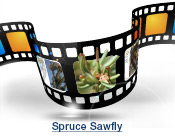| |
Spruce Sawfly - Forest Health and Adaptation | |
| |
|
|
| |
|
|
| |  {GFX-ESRDx-ForestHealth-SpruceSawfly-Slide2.jpg} Yellowheaded spruce sawfly (Pikonema alaskensis Rohwer), a pest of spruce, can cause serious economic and aesthetic loss to spruce trees. {GFX-ESRDx-ForestHealth-SpruceSawfly-Slide2.jpg} Yellowheaded spruce sawfly (Pikonema alaskensis Rohwer), a pest of spruce, can cause serious economic and aesthetic loss to spruce trees.
Larvae feed on the needles and can reduce plant growth and vigour for up to two years after the damage occurs.
Signs and Symptoms
Look for the following signs and symptoms of yellowheaded spruce sawfly infestation:
Branches/Twigs/Roots
- Clean and complete defoliation with needle stubs
- Dieback
- Presence of larvae
Crown
- Thinly foliated, fading green/yellow-orange or red-brown
Foliage/Buds
- Chewed needles
- Fading green/yellow-orange or red-brown needles
- Light longitudinal stripes along back and sides
- Presence of yellowish-green to dark green larvae with reddish brown heads
- Three pairs of thoracic legs and seven pairs of abdominal prolegs (up to 20 mm long)
Similar Damage
- Can be confused with other defoliating caterpillars. Look for larvae.
- This insect does not produce webbing and prefers the upper crown portion of the tree.
|
|
| |
|
|
| |
For more information about the content of this document, contact Devon Belanger.
This information published to the web on February 24, 2016.
|
|